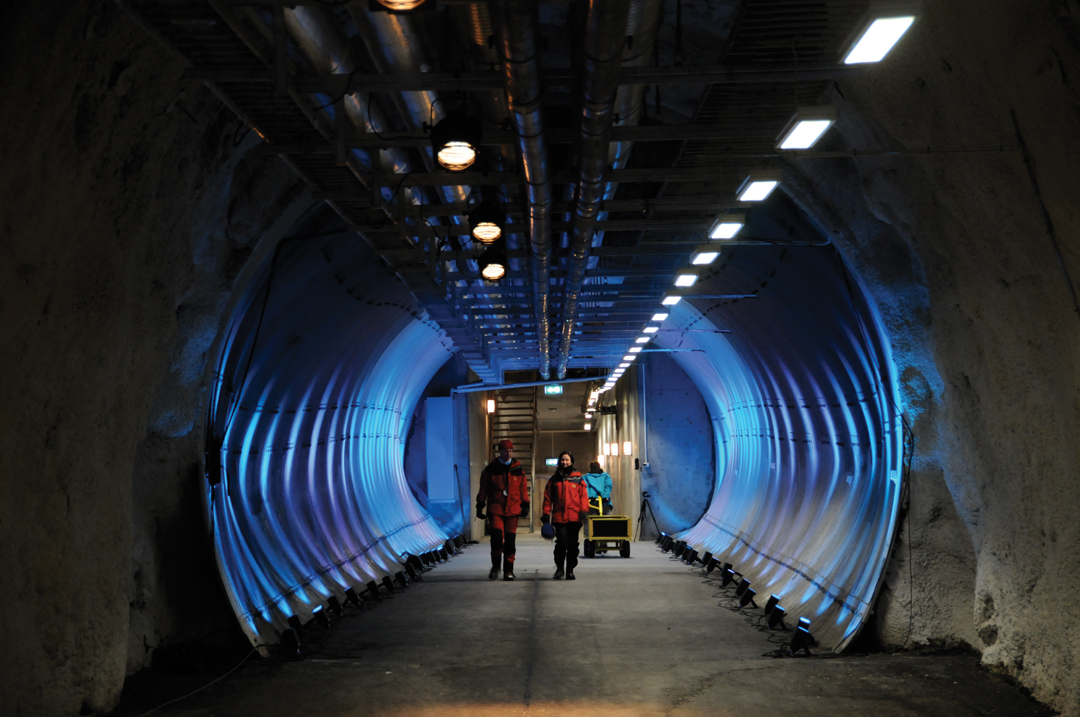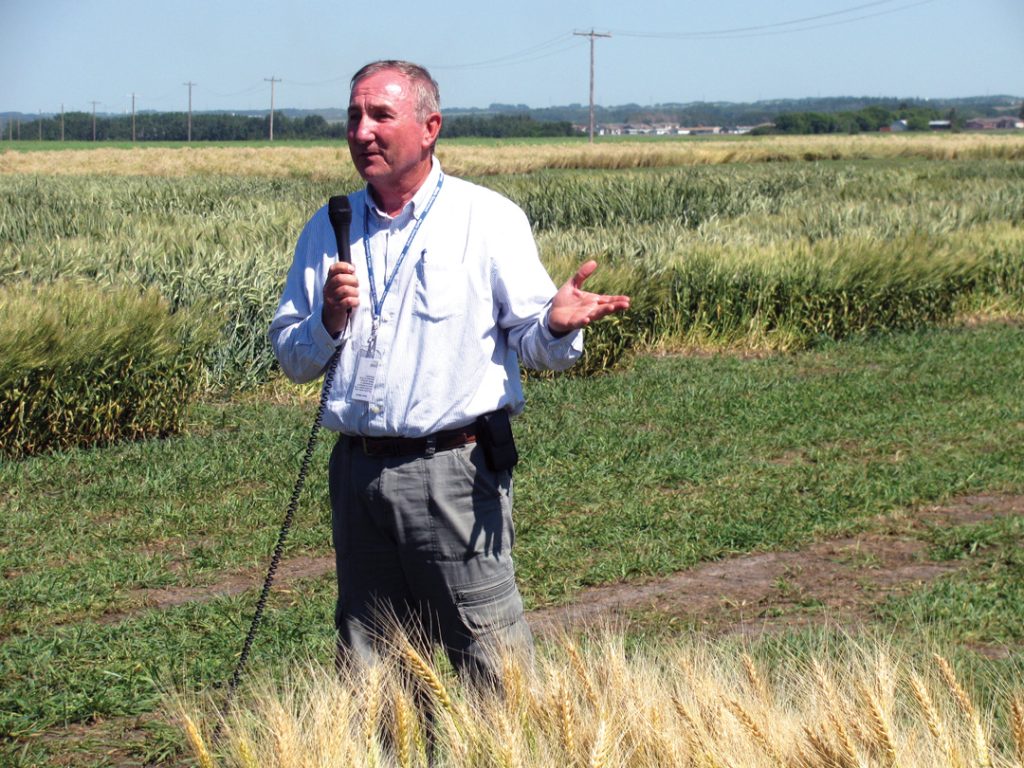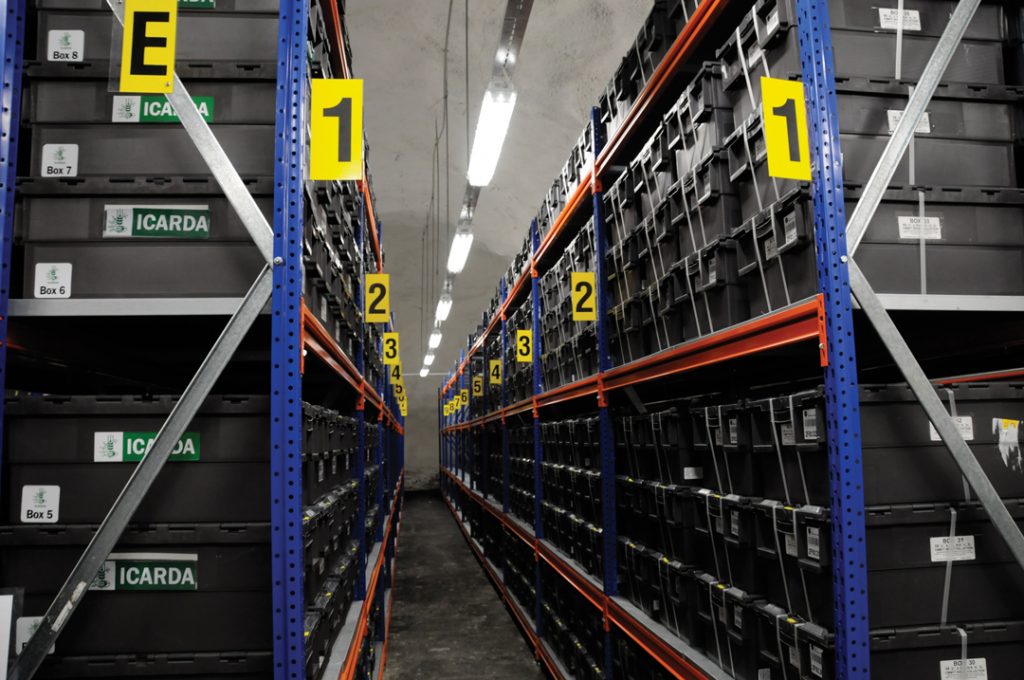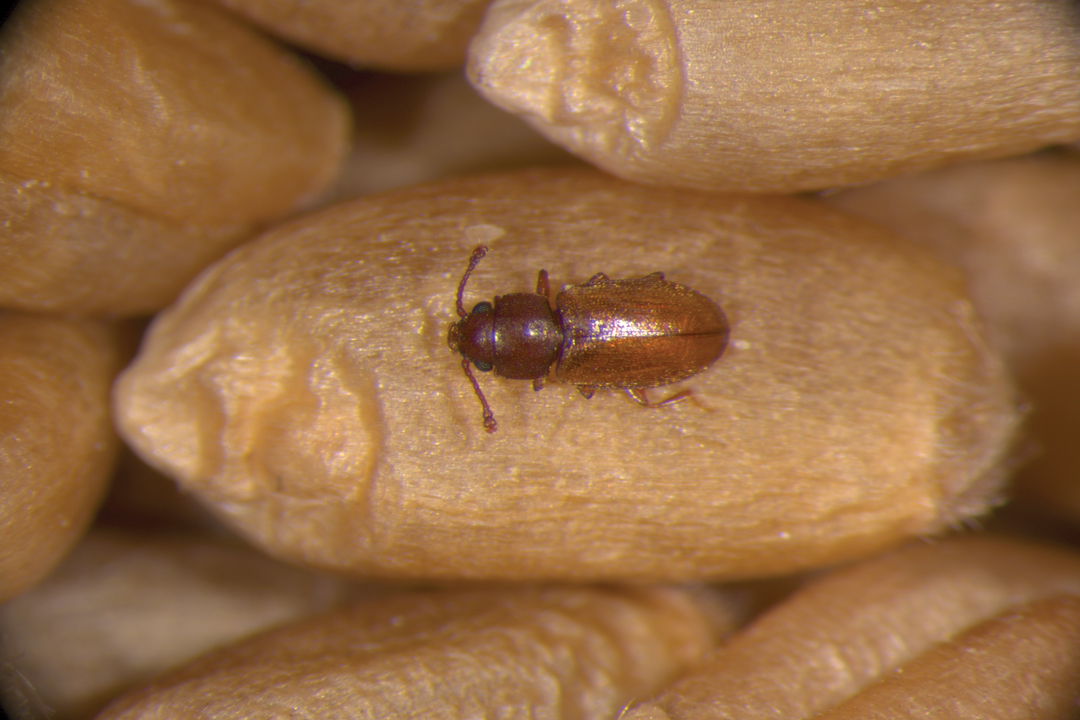SEEDS OF FUTURE PAST
GENE BANKS AND THEIR KEEPERS PRESERVE THE BUILDING BLOCKS OF AGRICULTURE
BY NATALIE NOBLE
There is nothing like the feeling of fall on the Prairies. The vibrant colours and sweet scents of another successful harvest before winter creeps in inspire festive get-togethers that are a farming tradition more than 10,000 years old. As we get set to give thanks this year, it’s fascinating to consider exactly where this year’s harvest originated.
Thomas Payne, head of the Gene Bank at the International Maize and Wheat Improvement Center (CIMMYT) based in Mexico City, thinks about this history a lot—he’s enjoyed a 40-year career contributing to its preservation.
“The crop varieties we hold in the gene bank are the result of legacies that thousands of farmers have been involved with,” he said. “From the times crops were first developed, each year men and women would have to sow the crop, tend to it, defend it from cows, neighbours, pests, the vagaries of climate, and then eventually they’d have to harvest the seed.
“After harvest, they would have a party, similar to our Thanksgiving celebrations today,” Payne added. “But you can imagine there were probably years in which the crop was not adequate to feed the farmers’ families. Yet they would have to intentionally retain a portion of that seed and not eat it, even though their children might be starving, in order to replant it. This happened year after year for 10,000 years. The seed that we conserve in the gene bank is a result of that altruistic management of genetic resources.”
This enormous contribution by generations of growers is a precious resource, as was recognized in 2001 by the Food and Agriculture Organization of the United Nations’ International Treaty on Plant Genetic Resources for Food and Agriculture. The Treaty protects the exchange and conservation of crop genetic resources among its member nations.
THE SEED CONSERVATION MOVEMENT
According to Stephanie Greene, a plant geneticist at the United States Department of Agriculture National Lab for Genetic Resources Preservation (NLGRP), the momentum that led to international crop conservation efforts started with concerns dating back to the 1970s.
“The genetic diversity of crops was disappearing all over the world as folks moved to more modern agriculture and adopted these modern hybrids and cultivars,” she said. “There was this growing recognition that we were losing material, losing diversity.”
This concern was coupled with the recognition that, in developing modern agriculture, growers were increasingly relying on varieties that were highly uniform, or genetically similar. The corn leaf fly epidemic in the U.S. in the 1970s brought this observation home for Americans.
“Across the landscape, we were growing varieties that all had the same susceptibility to this corn leaf fly. The epidemic at this time, and of course the resulting major economic ramifications, sort of jerked everyone’s heads up,” Greene said. “We realized we had to broaden the genetic base of our crop plants to protect us against these types of epidemics.”
This growing recognition spurred the establishment and funding of gene banks in the U.S. The NLGRP, based in Fort Collins, CO, serves as the security backup location for the entire U.S. collection of germplasm, with a distributive network of gene banks across the country. These are active collections, where individual curators are responsible for individual collections.
While preservation efforts were happening in the U.S., gene banks were also being established worldwide, as people began the work of collecting genetic material, storing it and learning how best to preserve the valuable plant diversity for an uncertain future. Currently, Plant Gene Resources Canada’s collection of more than 110,000 seed samples—which includes “wild and weedy relatives of crop species, cultivars and inbred parental lines, elite breeding lines, and some rare and threatened species and genetic stocks”—is housed at Agriculture and Agri-Food Canada’s Saskatoon Research and Development Centre.
Mazen Aljarrah is a wheat and triticale breeder from Syria who has been part of the team at the Field Crop Development Centre (FCDC) in Lacombe since 2008. Previously, Aljarrah worked with CIMMYT in Mexico and the International Center for Agricultural Research in the Dry Areas (ICARDA) in Syria, which gave him international experience with the multifaceted global gene banking system.
“As a breeder, genetic diversity is our first line of defense against any new disease strains or changes in environment,” he said. “With outside challenges, we have to find genes we are able to incorporate into the breeding of new varieties.”
Aljarrah said one of the most important aspects of his job is listening to farmers, and that the relationship between breeders and growers is strong.
“They will tell you what they need,” he said. “They are better than us in that they are growing the varieties on a large scale, they know what’s going on and they express their needs. We have to take their notes very seriously and address them in our breeding program.”
When grain growers from around Alberta report changes in climate conditions or that certain varieties are weak with lodging, lower in quality or have other issues, researchers at the FCDC go back to the drawing board to devise a new strategy for their breeding program to address those concerns for future varieties. This is when they go to their collection to find specific genes. The team involved in Lacombe’s wheat, barley and triticale programs rely mainly on the CIMMYT and ICARDA gene banks because of the unique wheat, barley and triticale collections each holds.
Over the years, selection for specific traits, such as yield and protein content, has resulted in narrow adaptation for crop varieties in the developing world. The uniformity that results from this type of breeding has advantages in terms of yield and quality. However, this narrow genetic base can also result in susceptibility to emerging pathogens.
“If we make such varieties more fragile against any emerging epidemics—and this is what’s happening—we have to find new sources, new genes,” Aljarrah said. “This is when we turn to our gene bank.”
Ironically, in order to find these “new” genes, breeders must look to the past and into the history of today’s crops.
CENTRES OF ORIGIN
In the world, there are six major independent agricultural centres of origin. This means most of the known crops originated in one of these six regions. For instance, while we grow wheat in Canada today, it likely was not grown here 300 years ago. It came from somewhere else.
If you visit the fields of Turkey, located at the intersection of two of these important centres of origin, you will see a place where wheat is treated with an almost spiritual reverence and it is considered sacrilege to so much as drop a loaf of bread on the floor. The country boasts a rich history of plant genetic resources and important plant diversity.
“The Turks really have this ingrained cultural respect for the crop and the plant. It’s considered to be extremely wasteful if you destroy or harm wheat,” Payne said. “There’s a cultural connection to the crop. That really was fascinating to me.”
Wheat was domesticated in that fertile crescent of the Middle East, while maize originated in Mexico and the potato traces its beginnings to Peru. In each of the centres, the original farmers started to domesticate the wild relatives of our modern-day plants. As a native of wheat’s historical birthplace, Aljarrah has a deep understanding of the early stages of crop breeding and the value that wild relatives and landraces, or locally developed cultivars, still hold today.
“The old-time farmers started by selecting good plants for their own needs, and that primitive selection led to emerging landraces,” he said. “In the Middle East, some farmers still grow these landraces, or blends of the same variety. Some plants may be taller than others, some may develop earlier than the others.”
What are the benefits of growing these landraces? The farmers in these areas are not necessarily looking for the highest yields. Instead, they are looking for quality and stability year to year. Because they are not pure varieties, but rather blends of slightly different genotypes, landraces are more stable than modern cultivars in the face of climate change, disease and other adverse conditions.
Without gene banks, the global agriculture community cannot possibly preserve these pockets of genetic diversity—diversity we might be forced to rely on sooner than we think.
A GLOBAL NETWORK
Brian Lainoff, partnerships and communications officer with the Global Crop Diversity Trust (Crop Trust), referred to gene banks, or global storage facilities, as agriculture’s insurance policies that contain the diversity from wherever a variety was originally found.
“They also allow us to use organic material to advance what we’re doing in agriculture,” he said. “Each one of the varieties preserved might carry one specific trait within that can be bred to create a new variety that will likely help us defend and improve agriculture.”
The Crop Trust refers to this genetic diversity as the building blocks of agriculture, and believes that its preservation is the foundation of food security.
There are more than 1,700 gene banks worldwide where plant material is properly conserved once it has been collected, tested and catalogued at one of the research centres around the world. Many gene banks are located in developing parts of the world, where funding is not easily accessible. Lainoff said that when the Crop Trust was established in 2004, it was clear that many of the gene banks needed funding and their contents were constantly at risk.
The goal at the Crop Trust was to fund the Consultative Group for International Agricultural Research (CGIAR) collections and establish a global system that was dependable and widely accessible, as well as consistent, cost effective, rational and efficient.
The Crop Trust’s global system is three-pillared. First are the collections of seeds that come from international banks, national collections and non-profit organizations like Seed Savers Exchange, which collects and conserves heirloom seeds and then makes them available for purchase. The international gene banks, including CIMMYT and ICARDA, store the majority of the most-used and most-important seeds. More than 750,000 varieties are held in trust by the international community and are available to the public by request or through the gene banks’ databases.
The next pillar of the Crop Trust’s foundation is the dissemination of information that ties the global system together. “We supply funding for information systems,” Lainoff said. “It’s like a spiderweb of interlinking collections that contain the world’s most unique diversity.”
Finally, the third pillar is the Svalbard Global Seed Vault built into a mountain on a remote archipelago halfway between the North Pole and mainland Norway. Difficult to reach, it is a four-hour flight north of Oslo and there are more polar bears than people on the island. Described by Lainoff as the “tip of the iceberg,” the facility acts as a backup hard drive for the world’s seed collections.
SVALBARD: MORE THAN JUST A “DOOMSDAY VAULT”
Perhaps the Crop Trust’s most talked-about initiative, the Svalbard vault currently holds more than 850,000 unique varieties. While it has the potential to store up to 4.5 million varieties, Lainoff estimates there are around 2.5 million unique varieties in the world, meaning the vault has more than enough room to serve its purpose. The facility’s 150-metre tunnel has two vault rooms plus one completely empty room. Lainoff describes the vault as one of his favourite places on Earth.
“When I’m in there, I feel completely disconnected from the rest of the world,” he said. “I feel something much bigger than me. It’s partly the presence of the vault, and also the way I feel about the work I’m doing.”
Payne, too, talked about the intrigue of the remote vault. “Svalbard is a high-profile operation. It’s something that really captures imaginations and attention. And so the vault has really elevated the public relations aspect of the need to conserve genetic resources.”
When the Svalbard vault was less than 10 years old, its importance was demonstrated with its first withdrawal in 2015—the ICARDA collection. The organization’s gene bank was formerly located in Aleppo, Syria, but ICARDA researchers had found themselves in the middle of an increasingly volatile situation as the country descended into civil war. As far back as 2006, the teams at the Crop Trust and ICARDA realized they needed to act quickly to preserve the collection. Together, they worked around the clock to get most of the collection’s plant diversity out of Syria and into the Svalbard vault.
“They were still sending boxes of seeds up there when the war was happening, which was crazy,” Lainoff said. “They were sending DHL packages of seeds to breeders and scientists during the war, but it was getting more and more difficult.”
Active collections like ICARDA’s need to be regrown in order to replenish the collection. Because of the tragic circumstances in Syria, it was no longer possible to do this type of work there. Fortunately, ICARDA was able to withdraw its collection from the vault and move it to the organization’s new headquarters in Beirut, Lebanon.
“Svalbard is really accomplishing what it is meant to accomplish,” Payne said. “It’s not intended to replace the global or national gene banks. Those gene banks are still critical because we maintain very close linkages with users of the materials, breeders and scientists.
“The other critical aspect of the seed vault is that it serves as a repository for the cultural heritage of seed,” he added. “We are all too aware of the vagaries of funding, the mishaps or priority changes that occur in times of change within institutions or governments. All of these things put collections at risk, and when material is lost from a collection, that’s equivalent to extinction. The Svalbard Global Seed Vault is the last bastion of conserving materials.”
We might not always think about where our food comes from, but the work generations of worldwide growers and breeders have done, and continue to do, to ensure the future of agriculture is absolutely something we should be thankful for.










Comments